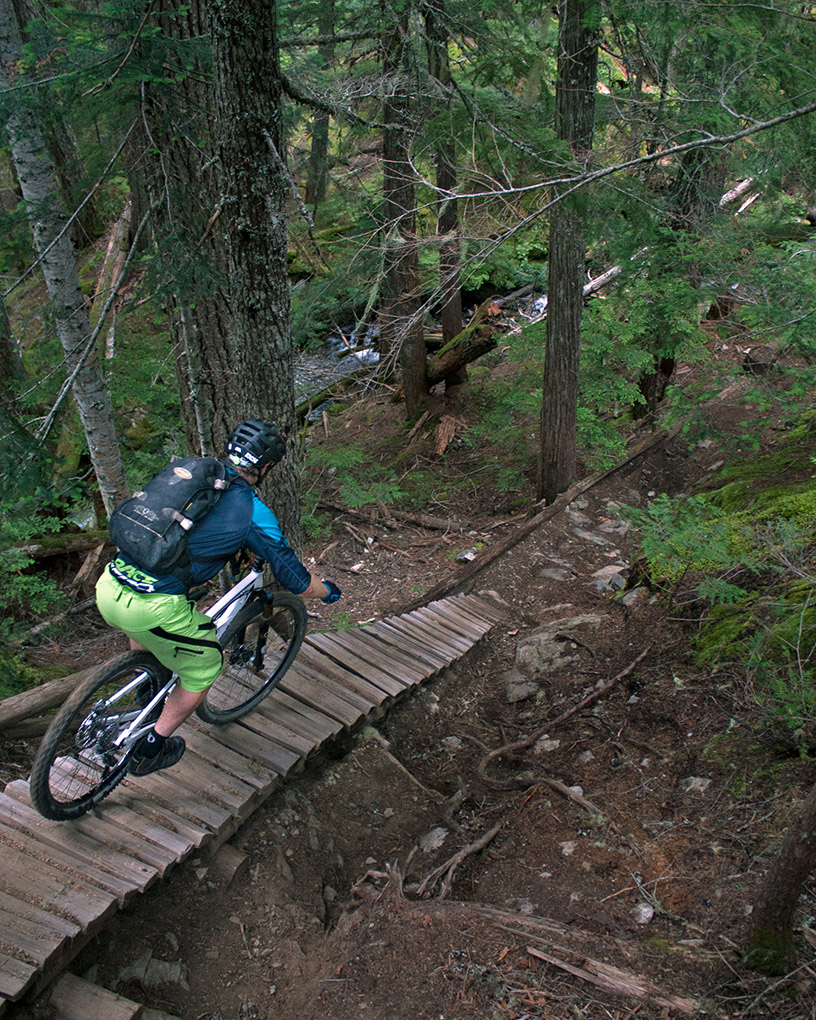Rear Suspension Performance
Pointed downhill with its rear shock in Descend mode, the Covert 29 likes to go fast, and maintains its composure while doing so. At higher speeds, the bike trims out and its suspension action becomes smooth and predictable. The long chainstays keep the bike stable in corners and planted when you straightline chunder.
On big hits, the CTD rear shock did tend to blow through its travel quickly, but never bottomed harshly. I fiddled with the air-spring pressure a few times to see if I could improve the mid-stroke support, but after running into the same issue regardless of pressure, I’ve decided a volume spacer kit might be the best option to solve this irk.
Braking
Comparing the Covert 29 to the other trail bikes we tested is a little unfair (considering it was the only 29” bike we tested out of the group) but I will note that it didn’t seem to brake as well as the Specialized Enduro or the Knolly Warden on steep rock slabs, where slowing yourself is critical to sticking your line. I would attribute this to two things. First, the Schwalbe Nobby Nic tires on the Covert 29, while light for their size, are underwhelming in most conditions and felt particularly undergunned for the trails we were riding. Second, while the B.A.L.L.S. faux-bar design does a good job of keeping things predictable, it doesn’t allow the bike’s suspension to act independently of braking forces.

Handling
I mentioned earlier that my first ride on the Covert 29 was a test for anyone’s balance and bike agility. A River Runs Through It in Whistler’s Valley is one of the coolest and more challenging slow-speed trails around. Its forest contours are littered with teeter-totters, skinnies, bridges, tight turns, obstacles and roots (lots of roots). This isn’t exactly the best proving ground for a slack 29” full suspension bike with wide handlebars.
I struggled to get the Covert 29 to play nicely on the balance-testing teeter totters, and strained to get the big-wheeled bike to whip around the tight turns, often having to rear-wheel hop the back end to make the tightest of turns. The Covert 29 does not like to go slow, threading its way around turns. Again, long chainstays and a 68° head tube angle make for a fast, stable bike, not an agile, playful one.
When you get the the Covert 29 rolling quickly over rock-infested, spider-web entangled rooty gnar, you’ll see where this bike shines. The bike’s big wheels and 140mm travel gobble up most anything. If the trail starts to straighten out, let off the brakes and let the Covert 29 do what it does best: plow over everything. While Whistler’s trails favor a more agile bike with more precise handling, I think the Covert 29 would thrive in areas like Moab and Sedona that allow for a lot of high-speed riding with plenty of square edge hits.
Riding in a group on fast trails, I also noticed I was able to make up ground on the other riders in corners on the Covert 29. If we were all traveling at the same speed entering the same berm in a line, I would often exit the berm having made up ground on the rider in front of me. I’d chalk this up to better traction from larger contact patches on the Covert 29’s wheels and the bike’s relatively short wheelbase, which is easier to pump through corners.
Durability Issues
This may be a fluke, but by the end of the week, I had blown the Fox shock’s DU bushings. This isn’t something I’m too concerned about since I go through a set of bushings on my bikes about every season, but I was surprised at how quickly the ones on the Covert 29 failed.
Bottom Line
The Transition Covert 29 isn’t the best bike for tight and technical trails, but it hauls through rough sections and carries momentum well through fast berms. If your local trails feature sit-and-spin climbs and fast, ripping descents, I think you’ll get along well with the Covert 29.

The Covert 29 has a majorly regressive leverage curve – not surprised it was bottoming out all the time. Very different from the linear design of the smaller wheeled versions. Afraid volume spacers may not do the trick – just too regressive.
Anywhere I can see a graph of that curve? or know what the ideal shock for it might be?